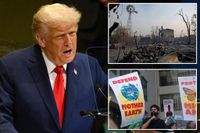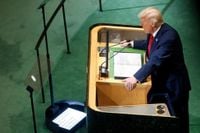On September 23, 2025, President Donald Trump took the stage at the United Nations General Assembly in New York, delivering a fiery 57-minute speech that left little doubt about his stance on climate change and the future of green energy in the United States. As world leaders gathered for Climate Week NYC and prepared for pivotal climate talks set for November in Brazil, Trump’s remarks—filled with scorn for renewable energy and skepticism toward climate science—sparked immediate debate both at home and abroad.
Trump’s address was anything but subtle. He dismissed climate change policies as “the greatest con job ever perpetrated,” riffing, “You know, it used to be global cooling. If you look back in the 1920s and 1930s, they said global cooling will kill the world. Then they said global warming will kill the world. Now they can just call it climate change, because that way they can’t miss. Climate change—because if it goes higher or lower, whatever the hell happens, is climate change. It’s the greatest con job ever perpetrated on the world.” According to The New York Post, his audience of foreign dignitaries greeted these pronouncements with a mix of murmurs and reserved expressions.
Trump’s skepticism wasn’t reserved for the science alone; he took direct aim at the technologies underpinning the green transition. Wind turbines, in particular, drew his ire. He called them “pathetic” and “expensive,” adding, “We’re not letting this happen in America.” Solar panels didn’t fare much better in his estimation, as he argued they were “taking away farmland.” He warned, “I’ve been right about everything, and I’m telling you that if you don’t get away from the green energy scam, your country is going to fail.”
These remarks were not empty rhetoric. Since returning to office, Trump has moved swiftly to reshape U.S. energy policy, often in ways that echo his long-standing personal grievances. Back in 2019, he lost a protracted legal battle over a North Sea wind farm that he claimed spoiled the view from his Scottish golf course. That defeat appears to have fueled his enduring animosity toward wind energy—an animosity now shaping policy at the highest level.
In April 2025, Trump ordered the Department of the Interior to halt construction on the Empire Wind project, an 810-megawatt wind farm off Long Island, New York. The project was revived the following month, thanks to the intervention of New York Governor Kathy Hochul, who reportedly struck a deal involving a natural-gas pipeline from Pennsylvania. Hochul’s office denied any quid pro quo, but the episode highlighted the precariousness of renewable energy ventures under the current administration.
Trump’s crackdown didn’t stop there. His administration canceled $679 million in funding for a dozen offshore wind projects at various stages of development. Construction was halted on the Revolution Wind farm off Rhode Island—a $6.2 billion project that was nearly complete. Plans to build a 114-turbine wind farm off the Maryland coast were shelved, and the New England 1 and 2 projects off Nantucket now face an uncertain future.
At a natural gas conference in Milan, Secretary of the Interior Doug Burgum declared, “Under this administration, there is no future for offshore wind.” His words underscored a dramatic policy shift: while the previous administration had pushed for a rapid transition to renewables, Trump’s team is focused on restoring what they call “basic evaluations of national security, commercial fishing, and environmental concerns,” and “unshackled traditional American energy sources such as domestic oil, gas, and nuclear power.”
The administration’s actions have had tangible consequences. According to a brief co-authored by Mariel Lutz of the Center for American Progress, the now-stalled offshore wind projects along the northeastern seaboard would have created roughly 12,000 direct jobs and 1,500 indirect jobs. The ripple effect on the business climate is also significant. Energy analyst Leon Stille wrote that pulling the plug on projects like Revolution Wind “sends a chilling signal to investors: no matter how advanced a project may be, no matter how rigorous the permitting process, politics can still override economics at the final stage.”
Yet, the debate over wind energy is hardly one-sided. Opposition to wind farms has come from unexpected quarters, including affluent communities like Martha’s Vineyard and even members of the Kennedy family, who previously opposed a Cape Cod wind farm to preserve their ocean views. Rural communities have also voiced concerns about noise and the visual impact of turbines, though a recent epidemiological study found no link between wind farms and other illnesses.
Trump’s critics argue that his approach is more personal than ideological. Richard L. Sweeney, an energy economist at Boston College, remarked, “It just seems crazy to stop these projects at this point.” He pointed to the latest Lazard annual report, which found that “utility-scale solar and onshore wind remain the most cost-effective forms of new-build energy generation on an unsubsidized basis.” In contrast, the cost of building new gas combustion engines has reached a ten-year high, and coal’s prospects are dimming fast. The U.S. Energy Information Administration projects coal plant energy generation will fall from 172 megawatts in 2025 to 145 megawatts by 2028—a trend unlikely to reverse.
Despite campaigning on promises to slash inflation, Trump has found energy prices stubbornly resistant to change. Experts attribute rising costs not to short-term shocks but to long-term increases in transmission and distribution expenses, exacerbated by the energy demands of new data centers—ironically, an industry Trump has encouraged to expand.
Within the Republican Party, reactions to Trump’s energy policy have been mixed. While many officials have echoed his rhetoric, House Speaker Mike Johnson of Louisiana broke ranks to support a wind project off the coast of Virginia, citing the state’s surging energy needs from its concentration of data centers. Yet, Trump’s campaign against offshore wind is expected to hit coastal blue states hardest, even as the top wind energy producers—Texas, Oklahoma, and Iowa—are deep red.
Trump’s speech at the UN also included a comparison of heat-related deaths between the U.S. and Europe, blaming high European tolls on expensive energy and a reluctance to use air conditioning. “So while the US has approximately 1,300 heat-related deaths annually—that’s a lot—Europe loses more than 175,000 people to heat deaths each year, because the cost is so expensive you can’t turn on an air conditioner,” he said. He offered U.S. energy supplies to any country in need, casting the nation as a potential global provider of affordable power.
As the dust settles from Trump’s UN appearance and his administration’s aggressive moves against wind power, the future of American energy policy remains deeply uncertain. Mariel Lutz, the policy analyst, summed up the mood among renewables advocates: “We will keep fighting.” For now, the battle lines are drawn, and the world is watching to see which way the wind will blow next.





